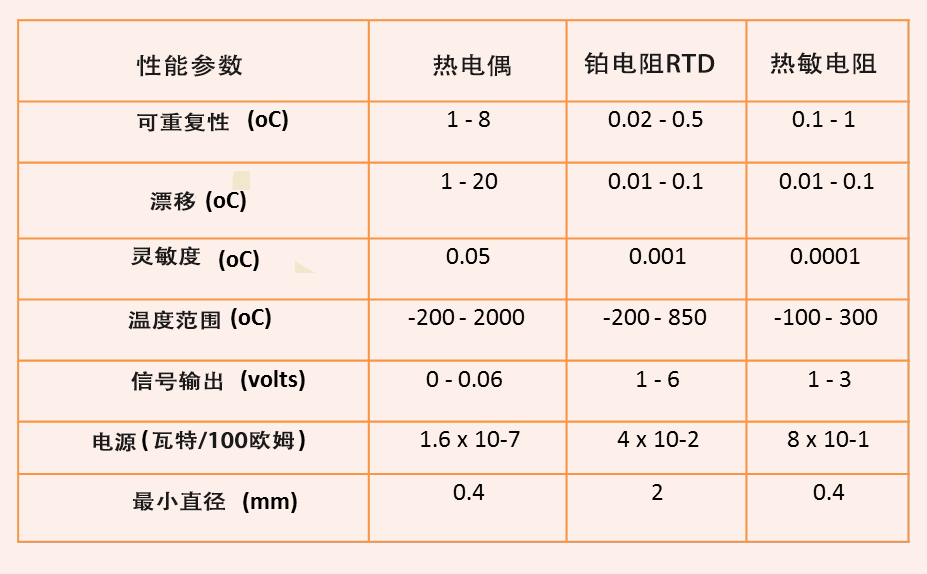

How to choose the best temperature sensor for industrial applications
In the industrial environment, the high process temperature, pressure and vibration make it necessary to use a strong temperature sensor. It also needs to respond quickly, accuracy, and stability. Although there are many types of temperature sensors, such as thermistor, infrared high temperature, fiber, etc., the two most commonly used in the process measurement industry are industrial temperature sensors such as resistor temperature detector (RTD) and thermocouple (TC) (TC) Essence
The sensitivity provided by RTD (the minimum temperature changes that can be detected), repeatability and drift are a magnitude of magnitude better than the thermocouple, as shown in Table 1-1. Two of the threshold sensitivity and repeatability are the two most important components of accuracy. Another most important component, resolution, is set by the transmitter. Drift is important for the time between extending calibration and the temperature circuit running correctly at the correct setting point.
The data in this table dates back to the 1970s, so it does not include the improvement of the technologies and quality and standard levels of thermocouple sensing component. However, the difference is so huge that the information is still the same. The temperature range displayed in the table is optimistic. When the temperature is higher than 500 ° C, the changes in the insulation resistance of the sensor's sheath will cause 10 ° C or more errors. There are many recognized advantages of thermocouple, but if you check them more carefully, you will find that they are not as important as what they think in the industry. The thermocouple is stronger than the RTD temperature sensor.
However, good thermal sleeve design and good installation practice make the RTD temperature sensor strong enough, even for high -speed flow and nuclear applications. The thermocouple seems to be cheaper until you start to include the cost of extending the lead and the cost of extra processes caused by the sensitivity and repetitiveness of the sensor. Regardless of the situation of using TC or RTD temperature sensors in the distributed control system (DCS), because the error introduced by these input cards is large span percentage, and the single sensor offset and drift errors cannot be corrected separately because they are Equipped with a dedicated temperature transmitter.

Table 1-1 The accuracy, range and size of the temperature sensing element
The IEC 751 standard describes the ideal relationship between the resistance of the platinum RTD temperature sensor and the temperature sensor affected by the RTD temperature sensor. The difference between the actual RTD temperature sensor curve and the ideal RTD temperature sensor curve can cause measurement errors, called sensor interchangeability errors. The Calleendar-Van Duseen equation provides an alternative to the IEC 751 standard.
This formula can be programmed into the transmitter so that the transmitter can use the actual RTD temperature sensor curve instead of the ideal curve (for example, IEC 751 standard) to convert the resistance signal of the sensor to the temperature value. The Calleendar-Van Dusen equation makes the transmitter calibrate with the sensor. When the sensor is replaced, the parameter of the equation is input into the transmitter. The main reason for selecting RTD or T/C can be summarized in the following list. In all cases, it is assumed to use the on -site temperature transmitter instead of the DCS TC or RTD input card.
Why use RTD instead of TC?
● RTD has better accuracy and repetitiveness.
● RTD signal is not easy to be affected by noise (higher signal -to -noise ratio).
● RTD has better linearity within the temperature.
● RTD can use the Calleendar-Van Duseen equation to provide the transmitter-sensor matching
● Cold end compensation has nothing to do with RTD.
● RTD drift is predictable, and T/C drift is unstable and unpredictable. In addition, element poisoning and oxidation at high temperature can cause TC drift errors.
● Due to mechanical impact, poisoning, and temperature circulation, changes that affect RTD or TC outputs will occur over time. These changes can be eliminated by online RTD calibration, and this option is not suitable for TC.
● RTD does not require a special extension line.
Why use TC instead of RTD?
● The function of TC at higher temperature (higher than 1100 ° F [593 ° C]) is better than RTD.
● Within common temperature range, TC sensors are cheaper than RTD. For integrated installation transmitters, the total installation cost of TC is low.
● TC has a faster response time than RTD, but this is only a consideration factors for naked components in the very fast temperature process (process time lags behind & lt; 10 seconds).
You should now recognize the importance of drift, threshold sensitivity, repetitiveness and range when selecting temperature sensors . These knowledge provides a basic first step, that is, setting the ability to control the circuit to keep the temperature and many ingredients at its best working point. The principle here can be extended to other sensors. In the next article, we will introduce the next step, that is, the sensor installation.

